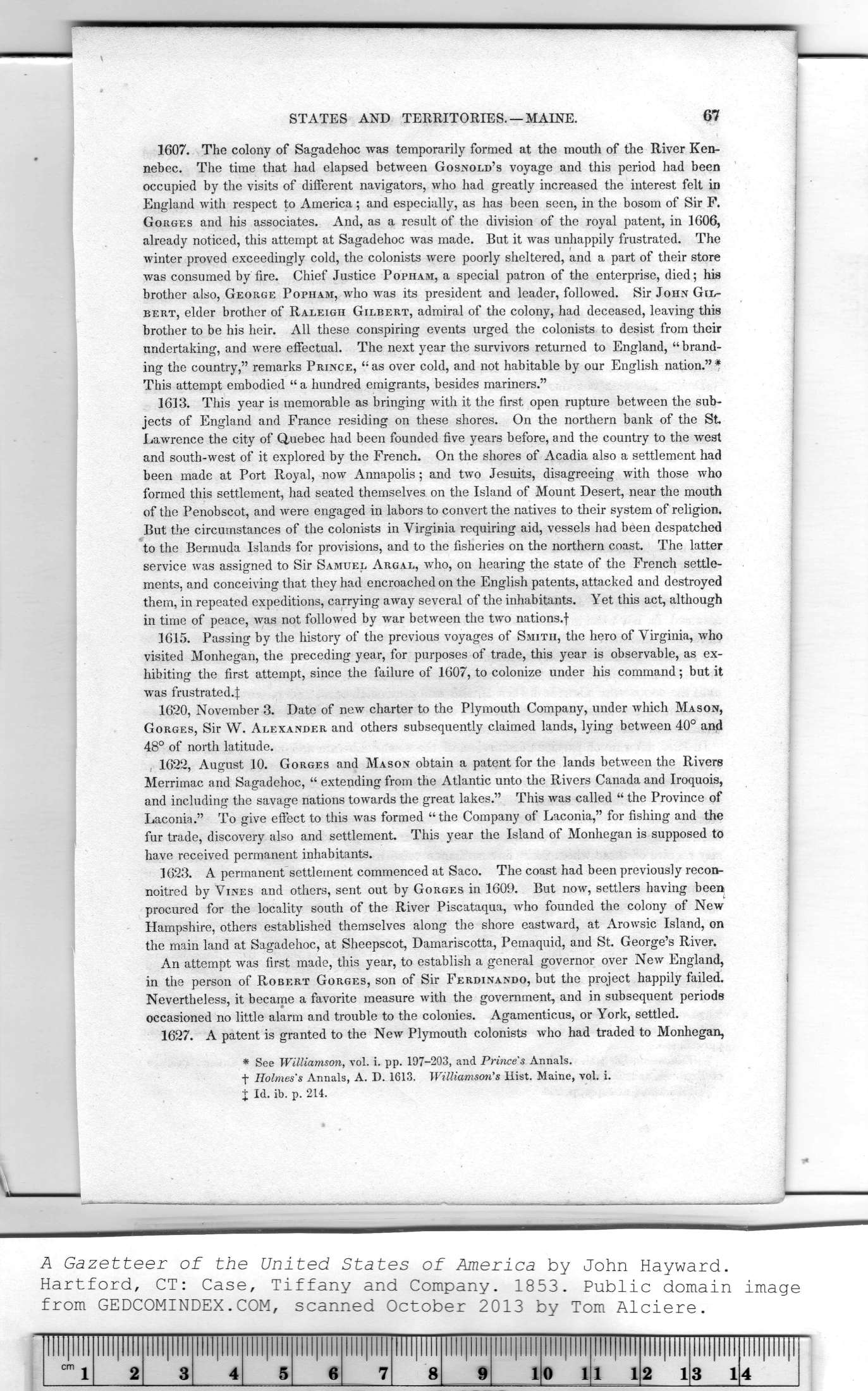|
|
Note: Ctrl and + increases the font size of the text below, Ctrl and - decreases it, and Ctrl and 0 resets it to default size.
STATES AND TERRITORIES. — MAINE. 67
1607. The colony of Sagadehoc was temporarily formed at the mouth of the River Ken-
nebec. The time that had elapsed between Gosnold's voyage and this period had been
occupied by the visits of different navigators, who had greatly increased the interest felt in
England with respect to America; and especially, as has been seen, in the bosom of Sir P.
Gorges and his associates. And, as a result of the division of the royal patent, in 1606,
already noticed, this attempt at Sagadehoc was made. But it was unhappily frustrated. The
winter proved exceedingly cold, the colonists were poorly sheltered, and a part of their store
was consumed by fire. Chief Justice Popham, a special patron of the enterprise, died; his
brother also, George Popham, who was its president and leader, followed. Sir John Gil-
bert, elder brother of Raleigh Gilbert, admiral of the colony, had deceased, leaving this
brother to be his heir. All these conspiring events urged the colonists to desist from their
undertaking, and were effectual. The next year the survivors returned to England, “brand-
ing the country," remarks Prince, “ as over cold, and not habitable by our English nation." *
This attempt embodied “ a hundred emigrants, besides mariners."
1613. This year is memorable as bringing with it the first open rupture between the sub-
jects of England and France residing on these shores. On the northern bank of the St
Lawrence the city of Quebec had been founded five years before, and the country to the west
and south-west of it explored by the French. On the shores of Acadia also a settlement had
been made at Port Royal, now Annapolis; and two Jesuits, disagreeing with those who
formed this settlement, had seated themselves on the Island of Mount Desert, near the mouth
of the Penobscot, and were engaged in labors to convert the natives to their system of religion.
But the circumstances of the colonists in Virginia requiring aid, vessels had been despatched
to the Bermuda Islands for provisions, and to the fisheries on the northern coast. The latter
service was assigned to Sir Samuel Argal, who, on hearing the state of the French settle-
ments, and conceiving that they had encroached on the English patents, attacked and destroyed
them, in repeated expeditions, carrying away several of the inhabitants. Yet this act, although
in time of peace, was not followed by war between the two nations.f
1615. Passing by the history of the previous voyages of Smith, the hero of Virginia, who
visited Monhegan, the preceding year, for purposes of trade, this year is observable, as ex-
hibiting the first attempt, since the failure of 1607, to colonize under his command; but it
was frustrated.!;
1620, November 3. Date of new charter to the Plymouth Company, under which Mason,
Gorges, Sir W. Alexander and others subsequently claimed lands, lying between 40° and
48° of north latitude.
1622, August 10. Gorges and Mason obtain a patent for the lands between the Rivers
Merrimac and Sagadehoc, “ extending from the Atlantic unto the Rivers Canada and Iroquois,
and including the savage nations towards the great lakes." This was called “ the Province of
Laconia." To give effect to this was formed “the Company of Laconia," for fishing and the
fur trade, discovery also and settlement. This year the Island of Monhegan is supposed to
have received permanent inhabitants.
1623. A permanent settlement commenced at Saco. The coast had been previously recon-
noitred by Vines and others, sent out by Gorges in 1609. But now, settlers having been
procured for the locality south of the River Piscataqua, who founded the colony of New
Hampshire, others established themselves along the shore eastward, at Arowsic Island, on
the main land at Sagadehoc, at Sheepscot, Damariscotta, Pemaquid, and St. George's River.
An attempt was first made, this year, to establish a general governor over New England,
in the person of Robert Gorges, son of Sir Ferdinando, but the project happily failed. I
Nevertheless, it became a favorite measure with the government, and in subsequent periods
occasioned no little alarm and trouble to the colonies. Agamenticus, or York, settled.
1627. A patent is granted to the New Plymouth colonists who had traded to Monhegan,
* See Williamson, vol. i. pp. 197-203, and Princes Annals.
•j- Holmes's Annals, A. D. 1613. Williamson's Hist. Maine, vol. i.
+ Id. ib. p. 214.
|
lllllllll |
lllllllll |
lllllllll |
lllllllll |
lllllllll |
llll|llll |
lllllllll |
lllllllll |
llll|llll |
lllllllll |
lllllllll |
lllllllll |
lllllllll |
lllllllll |
l!ll|ll!l|l |
|
|
2 |
3 |
4 |
5 |
6 |
7 |
8 |
9 |
1 |
0 1 |
1 1 |
2 1 |
3 1 |
4 |
|
